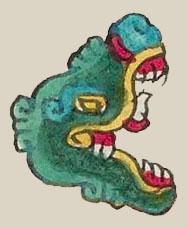oztotl (Mdz42r)
This compound glyph for cave (oztotl) represents the place name, Oztotlapechco, which is provided in a gloss. The cave appears to be the head of an animal in profile, looking to our right, with its jaws open. The head is largely green, with white teeth, red gums, a turquoise-colored eyebrow, white eye, and a yellow nose and lips.
Stephanie Wood
The curly features around the outer perimeter harken to the iconography of the stone (tetl), reminding us that there is actually a rocky outcropping around the mouth of the cave. Some interpret this animal as an earth monster. The corner of the mouth and the corner of the eye also possibly convey something of the curliness of the tetl sign. The opening of the cave is through the monster's mouth. According to the book In the Maw of the Earth Monster: Studies of Mesoamerican Ritual Cave Use, eds. James E. Brady and Keith Prufer (Austin: University of Texas Press, 2005), caves were sacred spaces, sites of rituals, and seen as providing access to the underworld, where there were divinities or deities. See also the analysis of caves by Holley Moyes, "Rites in the Underworld: Caves as Sacred Space in Mesoamerica," in Mexicolore, ed. Ian Mursell, where we learn that caves could overlap with the conceptualization of mouths and uteruses.
The open jaws provide access to the underworld that can be reached through the cave. A temple at the pre-Hispanic archaeological site of Malinalco has an entrance that involves walking through a serpent or an earth monster's open mouth, and the interior is round and dark, being somewhat cave-like. The ruins at Chalcatzinco also have a stone carving of a simulated cave entrance that involves an opening that is "zoomorphically depicted as the mouth of the mountain lord/lightning deity’s animal familiar or co-essence, which in some cases is a serpent, lizard or crocodile and in others a jaguar," according to John E. Staller (quoted in Mexicolore).
Stephanie Wood
c. 1541, or by 1553 at the latest
Stephanie Wood

ozto(tl), cave, https://nahuatl.wired-humanities.org/content/oztotl
cave (here, in profile view)
la cueva (en perfil)
Stephanie Wood
Codex Mendoza folio 42 recto, https://digital.bodleian.ox.ac.uk/objects/2fea788e-2aa2-4f08-b6d9-648c00..., image 94 of 188.
The Bodleian Libraries, University of Oxford, hold the original manuscript, the MS. Arch. Selden. A. 1. This image is published here under the UK Creative Commons, “Attribution-NonCommercial-ShareAlike 3.0 License” (CC-BY-NC-SA 3.0).

